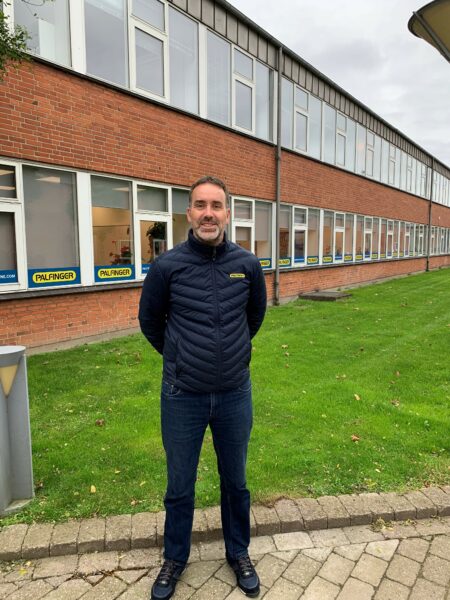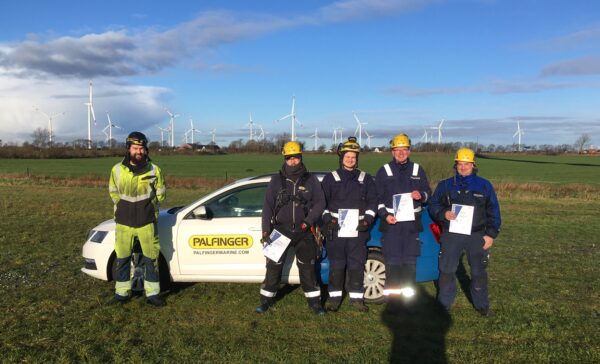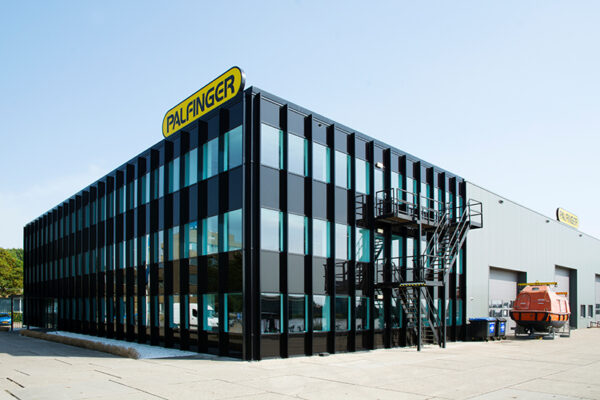Last Updated on October 25, 2021 by PALFINGER
A crane is a complex piece of equipment that requires expert handling, even more so in the setting of an offshore wind farm. But who trains the expert crane operators? Meet the PALFINGER crane specialists based in our Wind Hub Europe in Munkebo, Denmark.
When coming across a crane on a regular construction site, we often marvel at the perceived ease with which loads are lifted from one location to another. What we – more often than not – forget, is that this flowing movement is the direct result of a crane operator’s skill. Now imagine this task being executed in the harsh environment of an offshore wind farm. That makes the achievement even more impressive, does it not? Learn more about the PALFINGER experts that provide crane operator training for offshore wind farms.
The Wind Service Hub in Denmark
Crane operator training for offshore wind farms is a service provided via the PALFINGER Wind Hub Europe in Munkebo, Denmark. We met with Daniel Løfberg, a Service Coordinator at said hub, to discuss the increasing demand for crane operator training and how it actually works. Daniel explains: “What is important to understand is that PALFINGER has been offering crane operator training since it started manufacturing wind cranes – not only for the wind park owners’ personnel, but also for the personnel of third-party maintenance crews. Our focus in this respect is on transition piece cranes and nacelle cranes.”

Daniel Løfberg, PALFINGER Service Coordinator, in front of the office in Munkebo, Denmark
PALFINGER currently has a team of four dedicated crane trainers in Denmark and two in the Netherlands. “These trainers are often more senior staff members who act as mentors to younger marine engineers,” Daniel reveals. “These are the same experts one would call in to troubleshoot via the PALFINGER ‘Smart Eye’ app, for instance. Customers trust them, which strengthens the bond with our clients. This bond often leads to new maintenance contracts and allows us to familiarize the customer in question with our excellent spare parts department,” he smiles.
PALFINGER has been offering crane operator training since it started manufacturing wind cranes – for the wind park owners’ personnel, as well as for third-party maintenance crews.
Daniel Løfberg, PALFINGER Service Coordinator
Increasing Demand for Crane Operator Training
PALFINGER has registered a noticeable uptick in the demand for crane operator training recently. One of the latest major customers to request crane operator training is Siemens, specifically for its Gemini wind park in the Netherlands. As a service coordinator, Daniel has a unique insight into the market and an explanation at hand: “I believe that two main contributing factors are a need for competence documentation, which is coupled with health and safety considerations and insurance issues. Nevertheless, some training requests are still the result of damages caused by inadequate crane operation.”

Technicians of Siemens Gamesa successfully completed the PALFINGER crane operator training.
How to Train the Best
But how does one train a skilled crane operator? As mentioned above, PALFINGER provides the service to both the staff of wind park owners and operating personnel, who are not necessarily the same party. The training is always for a specific type of crane at a specific site. “Training sessions start off with theoretical lessons in a classroom of some sort, but practical training on the crane is, of course, an integral part of the process. Three hours of each usually do the trick,” Daniel reveals. “If the teams are larger in number, we may require a written examination to see whether everyone has internalized what we teach.”
A typical PALFINGER operator training focuses on …
- Safety
- Start up
- Control operation
- Safe operation
- Working position & load limits
- Parking position
Extensive Service Portfolio for Offshore Wind Farms
PALFINGER’s crane operator training service is yet more impressive proof of how the company strives to create value with partners. The setup in the background is structured accordingly. The Wind Hub in Denmark, which is part of PALFINGER’s European service execution headquarters in Schiedam, the Netherlands, is the single point of contact for all European wind farm customers. Most of them operate in Germany, the Benelux region, and the UK, as well as in France, which is an emerging market with great potential. Other service solutions in this field cover crane and LSA service for wind turbines and substations.

PALFINGER Service Execution Headquarter in Schiedam, the Netherlands
In order to fulfil the diverse customer requirements, some solutions offered by PALFINGER even go beyond its own product portfolio. These include, for example, servicing of turbine mounted safety equipment (TMSE) and wind turbine lifts. As a major customer for operator trainings, the Gemini offshore wind farm is also an impressive showcase project that encompasses an annual PALFINGER service package as mentioned above.
Scope of service solutions for offshore wind farms including substations:
- After sales and service
- Multibrand crane service
- Lifecycle service
- Refurbishment and upgrades
- Turbine mounted safety equipment (TMSE)
- Original spare parts
- Training
In terms of processing service requests, a flat structure allows for swift decisions and deployment of technicians. The Danish team in Munkebo takes the lead in discussing the nature and scope of service jobs with colleagues in the UK, the Netherlands, Germany, Poland and the Czech Republic before deciding who to deploy. The aspects considered in this process are skills, competencies, and cost effectiveness. All the while, the PALFINGER’s marine business headquarters in Salzburg, Austria, provides OEM (Original Equipment Manufacturer) support if needed.
In short: the wind farm service division is a perfect example for how PALFINGER’s structure is aligned to maximize customer benefit.
